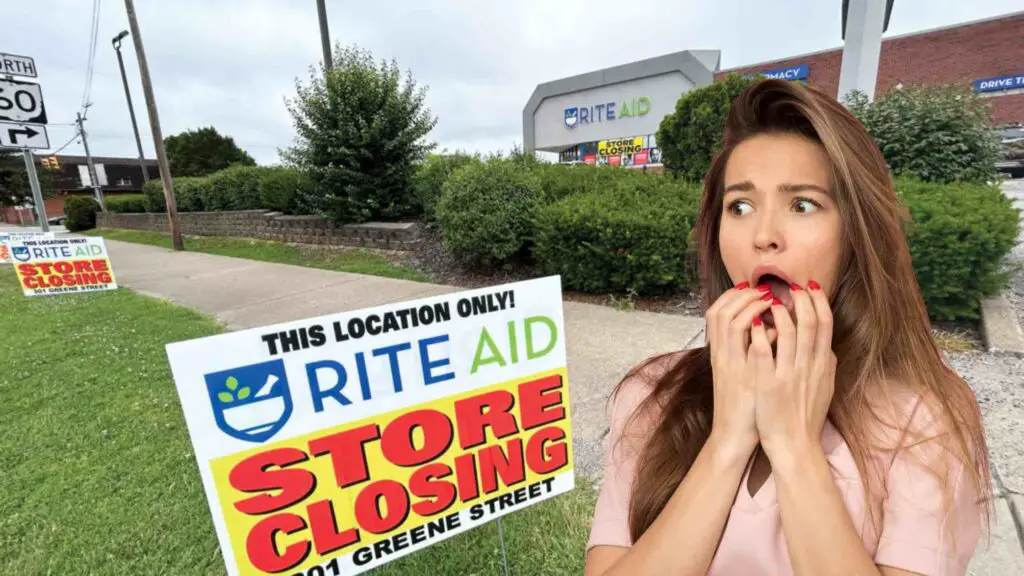Rite Aid is one of America’s longest-running pharmacy chains. For decades, it has been commonly seen in many neighborhood areas. However, the company’s recent financial difficulties forced it to file for Chapter 11 bankruptcy in October 2023. This decision has resulted in a significant restructuring process, including closing many outlets nationwide.
Many people are wondering if Rite Aid is closing all of its stores. It was because it had closed hundreds of locations around the country, especially a sizable number in Ohio and Michigan. This article explores the current state of Rite Aid stores and the effects of the company’s continuing downsizing efforts.
DiscontinuedNews is impartial and independent, and every day, we create distinctive, world-class programs, news, and content that inform, educate and entertain millions of people worldwide.
Bankruptcy and Restructuring

Rite Aid filed for Chapter 11 bankruptcy in October 2023. It was done mainly to restructure its debt and meet rising legal issues related to lawsuits. Thus, the company entered into Chapter 11 bankruptcy protection to:
- restructure its operations,
- manage its debts,
- examine its long-term contracts and leases
- continue to do business.
Rite Aid has also closed several stores. Its goal is to reduce failing locations and streamline operations.
Since its bankruptcy filing, Rite Aid has closed about 550 stores across the United States. The recent waves of closures have significantly affected Ohio and Michigan. These closures are part of Rite Aid’s efforts to cut expenses, improve its store footprint, and finally emerge from bankruptcy as a more efficient operation.
Store Closures
Reducing the number of operating stores is part of the business’ larger strategy. This is done to stabilize the company’s finances and position it for a prospective sale or restructuring. It might result in it emerging from bankruptcy with a leaner, more viable business model.
The Situation in Ohio
Rite Aid has closed multiple stores in Ohio, and the effects have been particularly severe here. The company’s strategy involves closing facilities that are no longer profitable and retaining others that still match performance standards. But the chain’s future in Ohio is uncertain, and the reports imply that more closures are coming.
According to a recent update, employees at Ohio Rite Aid sites have been notified of potential closures. It implies that all stores in the state could close over the coming weeks.
As of June 2024, Rite Aid had shuttered or planned to close 35 stores in the state. This includes an additional 16 locations in light of recent downsizing efforts. The closures have affected both urban and rural locations. It is leaving certain people with limited access to pharmacies.
The closures raised worries about the provision of vital health services. This is particularly true in areas where Rite Aid is the leading pharmacy.
Recent court filings and company statements confirm the closure of the following Rite Aid stores in Ohio:
- Alliance: 1895 West State Street
- Ashtabula: 2148 Lake Avenue
- Bowling Green: 722-740 South Main Street
- Cleveland: 3402 Clark Avenue
- Coshocton: 218 Chestnut Street
- Defiance: 1816 East Second Street
- Massillon: 242 Lincoln Way West
- New Philadelphia: 705 W. High Ave.
- Oregon: 3362 Navarre Avenue
- Springfield: 1805 South Limestone Street
- St. Marys: 1502 Executive Drive
- Tiffin: 530 West Market Street
- Toledo: 2434 West Laskey Road
- Warren: 1560 Parkman Road NW
- Wheelersburg: 8130 Ohio River Road
- Youngstown: 3527 Canfield Road
Michigan Store Closures
Michigan has also seen quite a few Rite Aid store closures. After the bankruptcy filing, Rite Aid announced the closure of 31 shops in Michigan, including 12 more locations, by June 2024. This has resulted in many communities losing access to pharmaceutical services.
People have been impacted not only by the closures. Hundreds of employees have lost their jobs as well. In response, local unions have begun discussing severance compensation. They are looking for other positions for affected employees. Despite these attempts, the closures have created a visible gap in many Michigan communities. This is particularly true in smaller towns with few other pharmacy options.
Rite Aid’s court filings have officially confirmed the closure of several stores across Michigan. The detailed list includes:
Detroit Metro Area
Detroit
- 18472 Livernois Ave.
- 10410 W. McNichols Rd.
- 16316 E Warren Ave.
- 17170 Harper Ave.
- 2700 W Vernor Hwy
- 20100 Grand River Ave.
- 13939 Livernois Ave.
Dearborn Heights
- 24619 W Warren St.
Westland
- 26601 Ford Rd.
Livonia
- 37311, 5 Mile Rd.
Southfield
- 21401 Grand River Ave.
Taylor
- 22401 Wick Rd.
Madison Heights
- 29001 Dequindre Rd.
Pontiac
- 400 N Perry St.
Roseville
- 31915 Gratiot Ave.
Warren
- 29150 Ryan Rd.
- 25845 Hoover Rd.
Ann Arbor and Surrounding Areas
Ann Arbor
- 2135 W Stadium Blvd.
Ypsilanti
- 401 E Michigan Ave.
Plymouth
- 44300 W 5 Mile Rd.
Canton
- 45340 Ford Rd.
Flint and Genesee County:
Flint
- 3802 Clio Rd.
- 2811 Davison Rd.
Burton
- 4101 E Court St.
Grand Rapids and Western Michigan
Grand Rapids
- 2419 Eastern Ave. SE
- 1550 Lake Dr. SE
Muskegon
- 2811 Henry St.
Holland
- 773 Lincoln Ave.
- Lansing and Central Michigan
Lansing
- 5011 W Saginaw Hwy
- 300 N. Clippert St.
East Lansing
- 1380 E Grand River Ave.
Northern Michigan and the Upper Peninsula
Traverse City
- 2453 W. South Airport Rd.
Marquette
- 1140 W. Washington St.
Sault Ste. Marie
- 446 W. Portage Ave.
Petoskey
- 1140 N US Hwy 31
Alpena
- 110 N. Ripley Blvd.
Gaylord
- 1150 W Main St.
Other locations in Michigan
Battle Creek
- 1401 Capital Ave. NE
Jackson
- 1110 W Michigan Ave.
Kalamazoo
- 400 S Drake Rd.
Bay City
- 3880 Wilder Rd.
Saginaw
- 2910 Tittabawassee Rd.
Port Huron
- 1309 24th St.
Owosso
- 1399 E M-21
St. Clair Shores
- 21701 Harper Ave.
Rite Aid is closing stores, and as the company’s reorganization process continues, more locations may be affected. The most recent information on any particular store closures is available on the Rite Aid website.
Rite Aid’s closures are not confined to Ohio and Michigan. The company has undertaken a nationwide effort to reduce its retail footprint, including store closures in other states, like California. The goal is to shed underperforming locations and focus on profitable ones.
The Future of Rite Aid Stores
While Rite Aid is closing many stores, it will not close all. The company wants to keep a smaller, more profitable network of stores that can continue to service clients efficiently. Rite Aid’s approach involves closing down unprofitable stores only. This strategy enables Rite Aid to focus on areas with a more significant market presence and can operate more effectively.
Customers can still find open Rite Aid locations in certain places. The business continues to offer pharmacy services both in-store and online. Yet, due to the ongoing restructuring process, Rite Aid may announce additional closures as it evaluates its long-term business strategy.
Employee Consequences
The financial impact of Rite Aid store closings goes beyond the loss of pharmacy services. The closures have resulted in job losses for numerous employees at the affected locations and the layoffs of hundreds of people in Ohio and Michigan alone. The loss of these positions has seriously hurt local economies, particularly in smaller towns.
The closures impact suppliers, delivery services, and other businesses. They all had agreements with Rite Aid outlets. Thus, as these outlets close, the companies relying on them for revenue also suffer.
Employees at the affected Rite Aid outlets are experiencing uncertainty and job loss. The business has offered some severance payouts, but the sudden nature of the closures has left many looking for new jobs.
According to reports, affected employees are given little notice, which affects their move to new roles. The local labor market will be critical in absorbing these job seekers. Matching Rite Aid’s healthcare benefits and employment security may be challenging.
Conclusion
The future of Rite Aid remains unclear as the firm deals with bankruptcy and restructuring. This strategy aims to make the business more financially stable. However, its success will depend on its ability to maintain customer trust and successfully compete with bigger rivals like CVS and Walgreens.
Rite Aid’s continuous struggles indicate more significant trends in the retail pharmacy industry. These include rising competition, changing customer tastes, and the effects of regulatory pressures. Rite Aid must adapt to these changes and discover new ways to flourish and meet its clients’ requirements.
Rite Aid’s story cautions against the challenges traditional retail pharmacies face in a rapidly changing industry. Industry observers and stakeholders will closely watch the company’s ability to rebound from bankruptcy and continue serving its customers.
